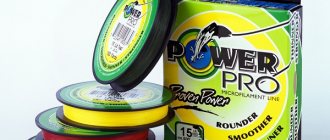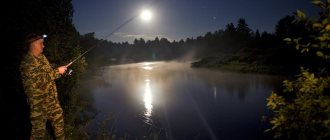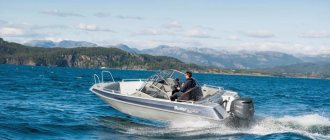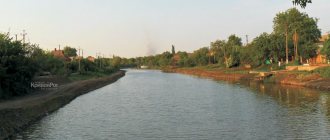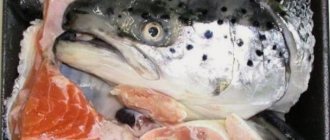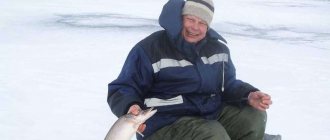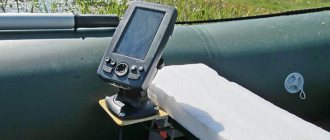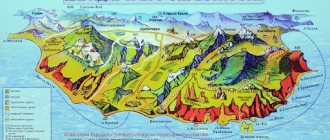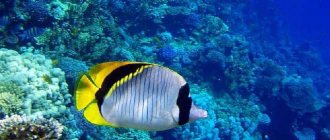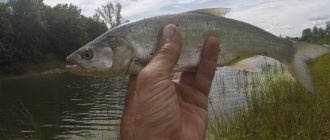Yuri 09/10/2020 455
In hot summer weather, a thermocline forms on lakes and ponds, an unknown phenomenon that has a significant impact on fishing. This phenomenon is observed in lakes and other stagnant bodies of water in the warm season. High air temperature heats the water; the heated upper layers of water have a density less than the lower layers.
The current in the river mixes the water and equalizes the temperature; in a lake or pond there is no current. Moreover, ponds with standing water are surrounded by trees and reeds, and even a strong wind does not stir the water. Under such conditions, the upper layers of water are several degrees warmer than the water at the bottom.
Temperature stratification of water greatly influences the behavior of fish. What should an angler do and how to catch fish in such conditions?
The essence of the term
Essentially, a thermocline is a middle layer of water with variable temperature, the difference at the upper and lower boundaries of which can reach ten degrees. It is formed due to the influence of three natural factors:
- solar heating;
- wind;
- change of day and night.
A thermocline is formed in mid-summer in stagnant bodies of water, where there is no important factor influencing the life of fish - current. Thus, the conversation can be conducted about the following locations:
- pond;
- lake;
- career;
- reservoir;
- quiet river bay;
- oxbow river bed.
Fresh water influx
Also, when talking about fishing on a reservoir, one cannot fail to mention the rivers that form it or simply flow into it. In some places they do not have a noticeable effect on the situation in a reservoir, but in certain cases the presence of a river is a fundamental factor influencing the behavior of fish. After all, what is a river? This is a current, which means fresh, cool water that attracts fish in thermocline conditions or when the water temperature is too high.
It is no secret that some reservoirs have direct contact with hydroelectric power plants, dams or nuclear ones - in the vast majority of cases, their waters are used to cool generators. Accordingly, the water in them is much warmer than in other bodies of water. Some of them do not freeze even in winter. Of course, for fans of winter spinning this is a very positive moment, but in the summer everything is not so clear.
At a certain point, the water temperature reaches such a point that fish activity drops to almost zero. And it is no longer possible to catch it either on the edges or during irrigation. In this case, you need to look for cooler water, and this, as we understand, is a water area that has direct contact with the inflow. In other words - with fresh cool water.
Education process
Let us consider the process of thermocline formation in more detail.
Attention! The highest density of water is observed at a temperature of 4 degrees Celsius.
When the spring sun melts the ice, active mixing of layers begins in the reservoir. The upper water becomes heavier and sinks closer to the bottom, while the lower water rises. This phenomenon, also called reverse stratification, occurs until the temperature reaches four degrees and levels out throughout the entire thickness.
With a further increase in temperature, natural mixing does not occur due to the fact that the density of water stops increasing, but naturally decreases. The so-called direct stratification occurs, when the deeper, the colder.
Now let's look at the influence of wind. Under its influence, the water in the upper layer is mixed and equalized in temperature. At the same time, its effect on the bottom horizon is zero; it remains just as cold there.
Between the layers there remains a thin strip of water with variable temperature, constantly decreasing with depth. It is this horizon that scientists call the thermocline.
Thus, in a summer reservoir we see the following picture:
- First comes the top, warmest layer, with a temperature approximately equalized throughout the thickness.
- Then there is a thin boundary layer - a thermocline, within which the temperature changes sharply from warm at the top to cold at the bottom.
- The lower, deepest and coldest layer, in which the temperature uniformly drops with increasing depth.
Approximate distribution of water at different temperatures at the thermocline
Scientists call the upper layer the epilimnion, the thermocline the metalimnion, and the lower layer the hypolimnion. Translated from Greek, these terms mean:
- Verkhneozerye;
- Sredneozerie;
- Nizhneozerye.
Important! In bodies of water where the influence of wind is minimal: steep banks, dense vegetation, a thermocline almost never forms.
There is also no thermocline in shallow ponds and bays, where wind mixing affects the entire water column and temperature stratification is not observed.
The influence of the thermocline on fish behavior
A thermocline is a layer of water in which the temperature differs sharply from the temperature of the underlying and overlying layers. The thickness of the thermocline can vary, from several to tens of meters. Science divides the thermocline into deep-sea and seasonal. Deep water can be up to two kilometers thick. His existence is permanent. The seasonal thermocline appears and disappears throughout the year, for example, when ice melts.
Anglers who use high-quality echo sounders to search for fish, which are capable of showing the thermocline zone on the display, know that the fish are almost always located above it. The fact is that the temperature difference inside the thermocline itself can be up to 10 degrees per meter of thickness. For most underwater inhabitants, crossing such a zone is a shock. It is no coincidence that those who like to breed aquarium fish, when transplanting them from container to container, always ensure that the temperature there is the same. However, there are fish species for which the thermocline is not an insurmountable obstacle, for example, vendace and smelt.
Much more inconvenient for fish than the temperature jump is the oxygen deficiency, which is established both in the thermocline itself and in the underlying and overlying layers.
Read: How does cloudiness affect fishing?
Saturation of water with oxygen occurs during the process of photosynthesis of plants in a reservoir, as well as from atmospheric air through the surface of the water. It is clear that both of these processes operate exclusively in the zone lying above the thermocline. There is almost no photosynthesis under it - it is dark. Oxygen, which entered the lower zone in the period before the emergence of the thermocline, that is, in the spring, is spent on the respiration of bottom inhabitants and on the processes of decay of bottom plants and organisms. And the higher the water temperature, the faster the decay processes go. As a result, in reservoirs with a stable thermocline, both in itself and in the underlying layers of water, an oxygen deficiency that is very unfavorable for fish occurs. This factor alone is the main reason why fish leave the zone below the thermocline.
It is important to keep in mind one more property of the thermocline, namely: the thermocline line, which is shown by modern echo sounders, is not affected by the bottom topography. And this is very important for fish.
As is already known, due to the lack of oxygen in the zone below the thermocline, fish stay above its border. For pike perch, pike, and bream this is an unnatural position. And if the bottom of the reservoir has areas rising above the thermocline, then these places become places where fish accumulate. Fishing here always has results.
Read: How to feel like a fisherman at home?
Summarizing the conversation about the thermocline and its influence on fishing in the hot season, we can say that the temperature stratification of water must be taken into account when determining fishing tactics. And if you don’t have an echo sounder with thermal indication, you should at least have an underwater thermometer.
Thermocline development
The formation of a thermocline in water bodies in the middle zone begins around the end of May. At first, its upper limit is at a depth of 1.5-2 meters. Many people have noticed when swimming that at a certain horizon the water clearly becomes colder.
As summer progresses, in most reservoirs the thermocline drops to a significant depth. So, for example, in Lake Onega by the end of summer its upper boundary is sometimes at depths of 30-50 meters.
On the other hand, where serious winds blow in summer and there are huge surface areas, as on the Rybinsk Reservoir, the thermocline sometimes collapses at depths of up to ten meters. Only deeper than this meaning does the situation remain normal.
A storm on the Rybinsk Reservoir is capable of mixing layers to great depths.
From the above, we can conclude that the thermocline is very mobile, and it is impossible to determine its location “by eye”. It is necessary to make constant measurements with a water thermometer or use an echo sounder with thermal indication.
Echo sounder operation
The thermocline on an echo sounder with a temperature sensor is very clearly visible. However, its border may appear somewhat blurry. This is not surprising, because the process of mixing water does not stop.
Moreover, the influence of the engine propeller, produced while moving across the water area, was added to the wind effect. The more fishing and pleasure boats there are in a reservoir, the more actively the water in the epilimnion mixes, and the lower the thermocline boundary drops.
Displaying the thermocline on the echo sounder screen.
Effect on fish
Ichthyologists and fishing enthusiasts who have good echo sounders know that mostly in summer, schools stay above the temperature jump zone. This is partly due to the fact that water can cool significantly with depth; they write that even 10 degrees per meter is not the limit.
Therefore, when fish overcome layers with different temperatures, they naturally experience some discomfort. This brings less unpleasant sensations to some species, for example, vendace or smelt, while others tolerate sudden temperature changes much worse.
The second significant factor of the thermocline is the presence of dissolved oxygen in the water. The most important gas for breathing comes from the atmosphere when the upper layers are mixed by the wind or as a result of photosynthesis of aquatic plants.
The aquatic plant even supplies oxygen to the aquarium.
Peculiarities of fish biting during the new moon in summer
Both sources of oxygen act mainly in the surface layer of water. Below, the wind does not work, and the plants are not able to receive enough sunlight.
It is because of this that in the lower part of the reservoir, in the hypolimnion and thermocline, many fish experience oxygen starvation and rise closer to the surface of the water. Predators concentrate in the upper layers of snags, peaceful fish rise to the shallows or to single navels at the bottom of the reservoir.
It must be taken into account that the thermocline boundary is not the same over the area of the reservoir and is not tied to its depths; it does not run parallel to the bottom or surface. Therefore, fish easily find places above the oxygen-poor zone; an echo sounder helps us find such areas.
The influence of the thermocline on fish
It's not just about water temperature. The surface layers of a lake or pond contain more oxygen. The wind mixes the water in the surface layers, aquatic plants are drawn to the light and grow in shallow areas.
They participate in photosynthesis and also release oxygen. Above the thermocline line, the water is warmer and there is more oxygen. Below it, the water is colder, and given that the bottom of the lakes is muddy, the fish will lack oxygen. This causes the fish to change their habits. The virtual thermocline line is jagged and does not cover the entire reservoir. It may be in one place and absent in another.
Fish behavior during the thermocline
The activity and bite of fish in the summer directly depends on the development of the thermocline in a particular reservoir. Below we will consider the influence of this factor on the most popular types.
crucian carp
Despite the fact that crucian carp is not very demanding on living conditions, and the thermocline period is not the most favorable for it. In hot weather, it tries to stand closer to the bottom in cool water, going out to feed in shallow water at dawn and dawn.
Attention! Sometimes crucian carp reaches the upper layers of warm water, where it can be successfully caught.
Crucian carp among coastal thickets of aquatic vegetation. Here a thermocline does not form, and the fish feels relatively comfortable.
Zander
Pike perch, unlike crucian carp, loves clean water, but its behavior in summer is largely similar. He prefers to wait out the heat of the day in cool water below the thermocline. Therefore, it is mainly caught during daylight hours with deep-sea jig baits.
The pike perch comes out into relatively shallow water following the small fish at dawn and stays here until dawn. At this time, it can be successfully caught using spoons or wobblers.
Morning dawn is the best time to catch pike perch using a wobbler.
Pike
The thermocline affects pike less than other fish. For her, the availability of food is more important. Therefore, in summer there is the most obvious division of the toothed into the grass and the deep. The first one watches for small things near thickets of aquatic vegetation, the second one lies in ambush near various bottom anomalies.
Attention! In cloudy weather and light rain, pike can hunt in any layer of water.
Pike likes to set up ambushes among thickets of underwater vegetation.
Perch
During the thermocline period, perch can be found in any layer. In this case, a pattern is observed:
- small sailors stand closer to the surface;
- humpback whales hunt closer to the bottom;
- at dusk, both come closer to the coastal aquatic vegetation and can be located in any layer.
During the thermocline period, the best baits for perch are spinners. They can be carried out in any water horizon and quickly detect a school of fattening predator.
Mepps Aglia #1 is the most popular spinner bait for perch.
Roach
Silver beauty almost always stands below the thermocline in those reservoirs where it is present. It is important for her to change the terrain where food particles accumulate. In rivers and small lakes where a thermocline does not form, roach prefers places near reeds, cattails, and reeds.
If there are trees on the shore that cast a shadow on the water, a flock of roaches can quite expectedly stand under them.
Rudd
The rudd, unlike its closest relative, is a pelagic and heat-loving fish. Therefore, you need to look for it at the water surface above the thermocline. Here she picks up small insects and other food that falls into the pond from above.
Attention! In summer you should look for rudd at the edge of aquatic vegetation in the upper layer of water.
